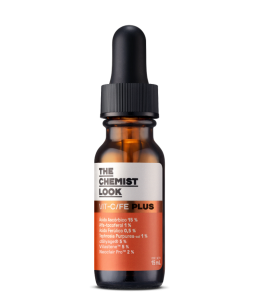The Chemist Look BOOSTER VIT-C/FE ANTI-STRESS

Ingredientes
Water
Dipropylene Glycol
Ascorbic Acid
Propylene Glycol
Glycerin
Propanediol
Lysine HCl
Lecithin
Phenoxyethanol
Tripeptide-9 Citrulline
Caprylyl Glycol
Tripeptide-10 Citrulline
Carbomer
Sodium Hydroxide
Laureth-23
Acetyl Tetrapeptide-2
Tocopherol
Propanediol
Tephrosia Purpurea Seed Extract
Ferulic Acid
Ethylhexylglycerin
Más información
Clínica y dermatológicamente testeado Cruelty-free Fórmula sin parabenos, fragancia ni alcohol Sin TACC
El análisis de ingredientes ha sido elaborado por investigadores del CONICET (*) en base a las siguientes referencias bibliográficas:
- Cosmetic Ingredient Review Assessments
- EC (Environment Canada). 2008. Domestic Substances List Categorization. Canadian Environmental Protection Act (CEPA) Environmental Registry.
- FDA (U.S - Food & Drug Administration) 2006 y 2008.
- Final Report on the Safety Assessment of Propylene Glycol and Polypropylene Glycols. (1994). Journal of the American College of Toxicology, 13(6), 437–491.
- US - FOOD & DRUG Administration (FDA). Generally Recognized as Safe (GRAS) Substances (SCOGS) Database (SCOGS Number 27,1973. Conclusion 1)
- Material Safety Data Sheet MSDS# 96129
- European Chemical Agency (ECHA)
- Cosmetic Ingredient Review (CIR) 2020.
- US - FOOD & DRUG Administration (FDA). Generally Recognized as Safe (GRAS) Substances (SCOGS) Database (SCOGS Number 106,1979. Conclusion 1)
- Material Safety Data Sheet MSDS# 96171
- Chasset, F., Soria, A., Moguelet, P., Mathian, A., Auger, Y., François, C., and Barete, S. (2015). Contact dermatitis due to ultrasound gel: A case report and published work review. The Journal of dermatology.
- Bohn, S., and Bircher, A. J. (2001). Phenoxyethanol induced urticaria. Allergy, 56(9), 922-923.
- CIR (Cosmetic Ingredient Review). Safety Assessment of Acrylates Copolymers as Used in Cosmetics (2018).
- Rillig, M. C., et al. (2019). Microplastic effects on plants. New Phytologist, 223(3), 1066-1070.
- Sussarellu, R., et al. (2016). Oyster reproduction is affected by exposure to polystyrene microplastics. Proceedings of the National Academy of Sciences, 113(9), 2430-2435.
- US - FOOD & DRUG Administration (FDA). Generally Recognized as Safe (GRAS) Substances (SCOGS) Database (SCOGS Number 85,1976. Conclusion 1)
- European Commission Legislation (Regulation (EC) N° 1223/2009 y 2019/831, Annexes I to VI and all the amendments to the cosmetics regulation).
- List of Safe and/or Natural Ingredients
- Aerts, Olivier
- Verhulst, Lien
- Goossens, An (May 2016). Ethylhexylglycerin: a low-risk, but highly relevant, sensitizer in 'hypo-allergenic' cosmetics. Contact Dermatitis. 74 (5): 281–288.
(*) Según el ranking SCImago 2020, el CONICET alcanza la segunda posición entre las instituciones académicas y de investigación más prestigiosas de América Latina. A nivel mundial, ocupa la posición 230 entre 7000 instituciones privadas y gubernamentales.
